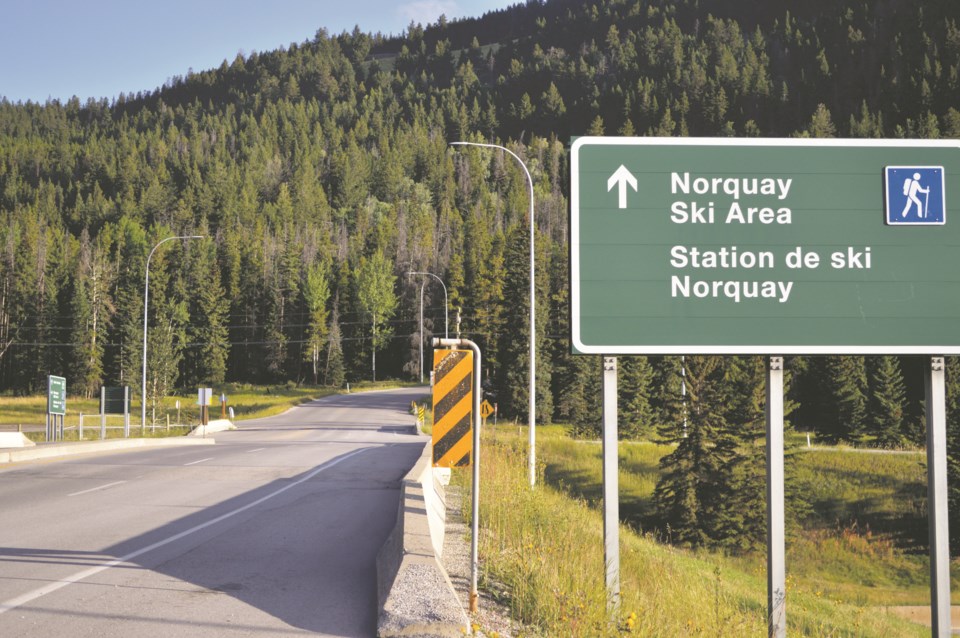Environmental groups are calling on Parks Canada to install a gate to restrict vehicles at critical times for wildlife on the Mount Norquay ski hill access road rather than considering a proposed aerial gondola to the summit.
Bow Valley Naturalists (BVN) and the Canadian Parks and Wilderness Society (CPAWS) have fired off a letter to Parks Canada, saying existing policy provides solutions to deal with increasing traffic, which cuts through an important travel corridor for grizzly bears, wolves and cougars.
They say the proposed gondola is simply another tourist attraction and call on Parks to act on Norquay’s existing long-range plan that identifies a series of steps to reduce wildlife disturbances due to increased traffic from the ski hill’s summer operation, including a gate with seasonal and dawn and dusk travel restrictions similar to the Bow Valley Parkway seasonal night-time closure.
“Summer operations at Mount Norquay were approved six-plus years ago and we are mystified as to why Parks Canada has not followed through with the commitments previously identified in the plan,” said Reg Bunyan, BVN’s vice-president.
“In spite of the implementation of a shuttle bus system, traffic volumes on the road have continued to increase on a yearly basis.”
The Cascade wildlife corridor is located on the north side of the Trans-Canada Highway, and links wildlife habitat to the east and west of the Banff townsite. Banff draws more than four million tourists a year.
Liricon, the personal financial holding company of Jan and Adam Waterous, which owns Mount Norquay ski hill and holds leases from Canadian Pacific Railway for the train station and surrounding lands has a vision for a car-free Banff.
Part of that includes a proposal to develop a year-round, high-alpine tourist destination through the construction of a four-station gondola from the Banff train station to the summit of Mount Norquay.
One of the proposed mitigations for the gondola includes reducing traffic, or decommissioning the road to Norquay.
Andre Quenneville, general manager of Mount Norquay, said they believe the best option to deal with the traffic problem on the access road for wildlife is to build an aerial gondola.
“We definitely agree that traffic on the Norquay Road is a problem and reducing it is a priority,” he said.
“That’s why we completed the feasibility study for the aerial transit for the gondola.”
As part of the feasibility study, Norquay commissioned the Miistakis Institute, which specializes in evaluating complex environmental problems, to look at the impacts of shutting the road and building a gondola.
“Basically, their study shows it would be a positive environmental gain and help restore ecological integrity,” Quenneville said.
“What we’ve seen so far is obviously the gondola would be the best solution to reduce traffic by upwards of 99 per cent in this wildlife corridor.”
Norquay’s 2013 long-range plan has a series of strategies to reduce the negative effects vehicle traffic has on wildlife travelling through the Cascade wildlife corridor, including a transportation strategy that calls for 100 per cent of ski hill patrons to bus to the hill.
In addition, there's a requirement in the site guidelines to reduce the frequency of disturbance on the Mount Norquay access road through the Cascade wildlife corridor to below certain thresholds.
The long-range plan states management actions would be considered if monitoring data shows that vehicle disturbances are routinely exceeding the baseline levels established in 10 years ago in 2009.
One of the mitigations involves consulting the public on implementing a road restriction by time and season similar to the Bow Valley Parkway, and/or road restrictions that would only allow buses and authorized vehicles by Parks Canada during the summer, for example.
“A seasonal road or vehicle restriction is considered as a final option, if all other action have been reasonably attempted and proven ineffective,” according to the long-range plan.
BVN and CPAWS say that Parks Canada’s own road monitoring data clearly shows that traffic has been increasing year by year and that acceptable thresholds for wildlife are consistently being exceeded, despite Norquay’s shuttle bus system.
Bunyan said implementing some of the steps identified in the long-range plan, such as the gate and road restrictions or closures at certain times, has the potential to be simpler, more effective and a far better environmental option then a gondola.
“The gondola should be regarded as the ‘nuclear option,’ an option that has the potential to create as many or more impacts than what it might or might not resolve,” he said.
Quenneville said Norquay offers a shuttle bus system in both winter and summer, noting the summer shuttle has gone from bringing up 12 per cent of the ski hill’s guests to more than 21 per cent.
“We feel it’s been great in reducing the amount of folks travelling up in their own private vehicles,” he said.
“I don’t think we’re the only ones that have seen an increase in traffic, but I would argue our numbers have stayed relatively low compared to numbers that have increased significantly throughout the rest of the park.”
Norquay submitted its feasibility study in May 2018 and received a response from Parks Canada in spring 2019.
“They had a few more questions that they had some concerns over, and part of those questions relates back to the wildlife corridor and other things related to our site guidelines,” said Quenneville
“We’re at the point right now where we’re working on answering those questions.”
Parks Canada officials did not provide an interview, but an emailed statement said that the agency is committed to long-range planning and working to fulfill objectives in the Mount Norquay long-range plan.
“Parks Canada is currently in the process of reviewing traffic volume data against thresholds identified in the Mount Norquay Site Guidelines and the Mount Norquay Long Range Plan,” wrote Carly Wallace, a media spokesperson for Banff National Park.
“Once this review is complete, the agency will determine next steps.”




